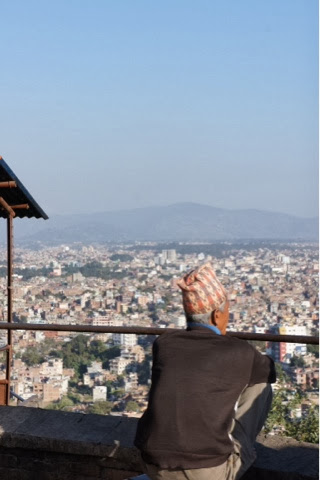We started our free day in Kathmandu by wandering through the shops of busy Thamel to Durbar Square. Kathmandu's Durbar Square (Durbar means "palace") was where the city's kings were once crowned and from where they ruled. During the 15th century the Kathmandu valley was divided into three independent Malla kingdoms, all with their own Durbar Squares: Bhaktapur (where we stayed our first three nights in Nepal), Patan, and Kathmandu. Rivalry and wars between each other left each state vulnerable to the 1768 invasion of the valley by the Gorkha backed Prithvi Narayan Shah. He is seen as the father of modern Nepal as the ensuing Shah dynasty unified Nepal and made Kathmandu it's new capital, a position the city still holds today.
Kathmandu owes its name to the Kasthamandap temple in Durbar square, a three roofed wooden building constructed in the 12th century supposedly from the wood of a single sal tree.
The Maju Deval temple in the square is often referred to as the hippie temple, as during the hippie era many people sat upon its steps and smoked the ganja. Back in the 70's when the now tourist area of Thamel was mere farm land, the area around Durbar square known as Freak street was filled with westerners who had traded their suits for loose fitting clothing and the stress free pie and chai shops of Kathmandu; a place at the end of the popular hippie trail from Europe where you could melt your troubles away.
Kumari Ghar is a palace where the Royal Kumari resides. The Kumari Devi is a young Nepali girl chosen according to a list of 32 strict physical requirements and other attributes, ranging from the colour of her eyes and the shape of her teeth to the sound of her voice. Suitable candidates are then left in a darkened room while terrifying noises are made and men dance in horrific masks with 108 gruesome buffalo heads on display. Only a young girl who remains calm and collected through this ordeal can be the Kumari.
The window the Kumari Devi appears at
Her final test is to be able to correctly select items of clothing worn by the previous Kumari. At this point it is said that the goddess Taleju enters her body and the Kumari becomes a living goddess. At the time of her first menstruation or any other major loss of blood the goddess vacates her body and a new Kumari is chosen. The previous Kumari reverts back to the status of a mere mortal and she is given a handsome dowry. (Though marrying an ex-Kumari is considered unlucky). We were too late to see the Kumari (she appears to the public every day until noon and after 4 in the window) but we did see the window she appears at.
After Durbur Square we navigated our way across the river and up the hill to the Buddhist Swayambhunath Temple, also known as the monkey temple. The temple sits perched high on top of a hill overlooking the Kathmandu valley below, and is centred around a giant white stupa topped by a spire painted with the eyes of the Buddha.
Each political party has a symbol - a tree, an umbrella, a sword...Dave said he would vote for the sword party
After taking in the stupa, the monkeys and the view from the top we made our way back down and managed to find our way back to our guesthouse (a feat harder than one would think in Kathmandu!) We had our last Nepali dinner at a wonderful restaurant nearby in a courtyard with music and dancing to entertain us, and we reminisced about what a wonderful time we'd had getting to know Nepal!
So much garbage on the streets
Cremation Ghat on the way back from the temple
Our final dinner in Nepal (with Chilean wine!)
























No comments:
Post a Comment